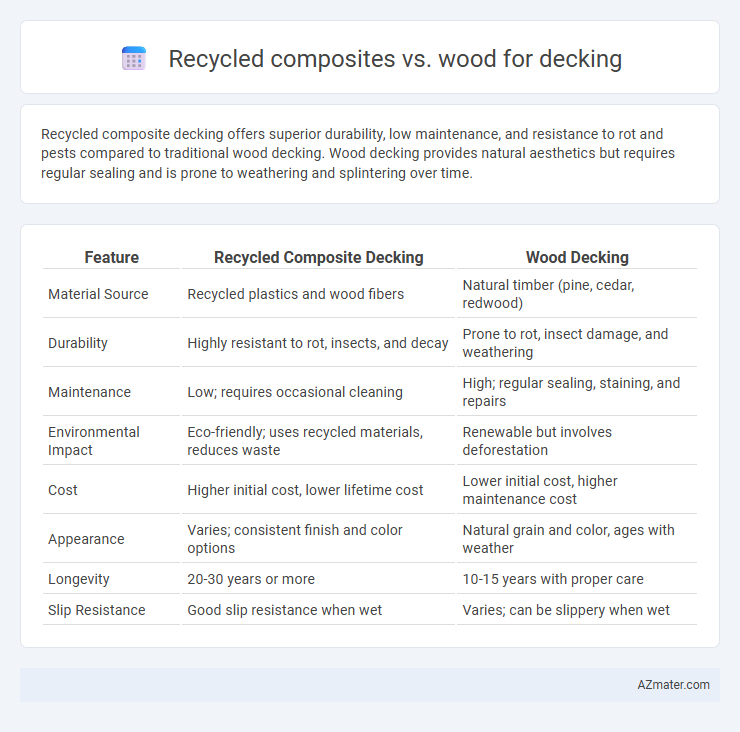Recycled composite decking offers superior durability, low maintenance, and resistance to rot and pests compared to traditional wood decking. Wood decking provides natural aesthetics but requires regular sealing and is prone to weathering and splintering over time.
Table of Comparison
| Feature | Recycled Composite Decking | Wood Decking |
|---|---|---|
| Material Source | Recycled plastics and wood fibers | Natural timber (pine, cedar, redwood) |
| Durability | Highly resistant to rot, insects, and decay | Prone to rot, insect damage, and weathering |
| Maintenance | Low; requires occasional cleaning | High; regular sealing, staining, and repairs |
| Environmental Impact | Eco-friendly; uses recycled materials, reduces waste | Renewable but involves deforestation |
| Cost | Higher initial cost, lower lifetime cost | Lower initial cost, higher maintenance cost |
| Appearance | Varies; consistent finish and color options | Natural grain and color, ages with weather |
| Longevity | 20-30 years or more | 10-15 years with proper care |
| Slip Resistance | Good slip resistance when wet | Varies; can be slippery when wet |
Introduction: Choosing the Best Decking Material
Recycled composite decking combines reclaimed plastic and wood fibers, offering enhanced durability and low maintenance compared to traditional wood. Wood decking provides natural aesthetics and can be more affordable initially but requires regular sealing and is prone to rot and insect damage. Selecting between recycled composite and wood depends on budget, desired longevity, and environmental considerations.
Overview of Recycled Composite Decking
Recycled composite decking is made from a blend of recycled plastics and wood fibers, offering enhanced durability and resistance to moisture, rot, and insects compared to traditional wood. This decking material requires minimal maintenance, eliminating the need for sanding, sealing, or staining, while providing a consistent appearance over time. Its eco-friendly composition reduces landfill waste and supports sustainable building practices, making it a popular choice for modern outdoor decking projects.
Overview of Wood Decking
Wood decking offers a natural aesthetic with a variety of species such as cedar, redwood, and pressure-treated pine, providing warmth and traditional appeal to outdoor spaces. It requires routine maintenance like sealing, staining, and protection from rot and insect damage to extend its lifespan and maintain its appearance. Despite higher upkeep, wood decking remains favored for its authentic texture, affordability, and ability to be easily customized or repaired compared to recycled composite materials.
Durability and Longevity Comparison
Recycled composite decking demonstrates superior durability and longevity compared to traditional wood, resisting rot, insect damage, and warping caused by moisture and temperature fluctuations. Unlike wood, which often requires frequent sealing, staining, and maintenance, recycled composites maintain their structural integrity and appearance with minimal upkeep over 25-30 years. This enhanced durability reduces replacement frequency and long-term maintenance costs, making recycled composite a more sustainable and cost-effective choice for decking.
Maintenance Requirements
Recycled composite decking requires significantly less maintenance compared to traditional wood, as it resists rotting, warping, and insect damage without the need for regular sealing, staining, or painting. Wood decking demands periodic sanding, sealing, and treatment to prevent moisture absorption and decay, increasing long-term upkeep costs and labor. Composite materials also offer improved durability against weather elements, reducing the frequency and intensity of maintenance efforts.
Environmental Impact and Sustainability
Recycled composite decking significantly reduces landfill waste by utilizing reclaimed plastics and wood fibers, lowering the demand for virgin timber and preserving natural forests. Wood decking, while biodegradable, often involves deforestation and chemical treatments that can harm ecosystems and increase carbon emissions. Choosing recycled composite materials supports circular economy principles and offers a longer lifespan with less maintenance, enhancing overall sustainability.
Aesthetic Appeal and Customization
Recycled composite decking offers a consistent, sleek appearance with a wide range of colors and textures that mimic natural wood while resisting fading and staining. Wood decking showcases unique, natural grain patterns and rich tones that evolve over time, providing an authentic, rustic charm. Customization options for composites include pre-manufactured styles and integrated accessories, whereas wood allows for more versatile cutting, staining, and finishing tailored to personal design preferences.
Cost Analysis: Upfront and Long-Term
Recycled composite decking typically involves a higher upfront cost compared to traditional wood, often ranging from $30 to $45 per square foot versus $15 to $25 for wood. Long-term expenses favor composites due to lower maintenance costs, as they resist rot, insects, and weathering without requiring regular sealing or staining, saving homeowners money on upkeep and repairs. Wood decks may incur additional expenses over time including refinishing and replacement of damaged boards, which increases the total cost of ownership compared to the more durable and low-maintenance recycled composite options.
Safety and Comfort Factors
Recycled composite decking offers enhanced safety through its slip-resistant surface and resistance to splintering, reducing injury risks compared to traditional wood. Its low thermal conductivity keeps the deck cooler underfoot, providing superior comfort in hot weather. Wood decking, while natural, requires frequent maintenance to prevent splinters and warping, which can compromise safety and comfort over time.
Final Verdict: Which Decking Material Wins?
Recycled composite decking outperforms wood in durability, requiring less maintenance and resisting rot, mold, and insect damage, making it ideal for long-term outdoor use. Wood decking offers a natural aesthetic and can be more affordable initially but demands regular sealing, staining, and repairs to maintain its appearance and structural integrity. The final verdict favors recycled composite decking for its eco-friendliness, longevity, and lower lifetime costs, providing superior value for modern decking projects.

Infographic: Recycled composite vs Wood for Decking
 azmater.com
azmater.com